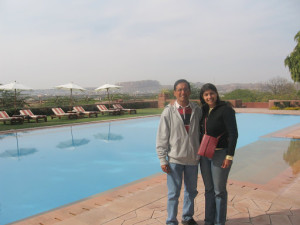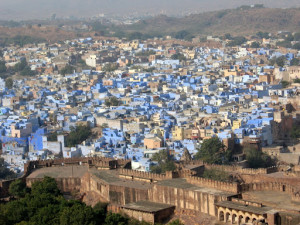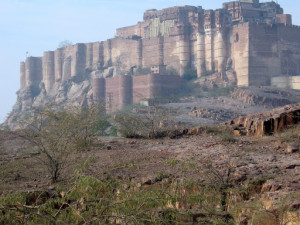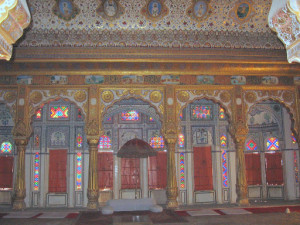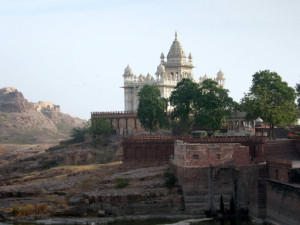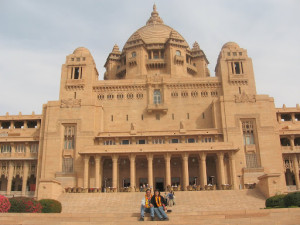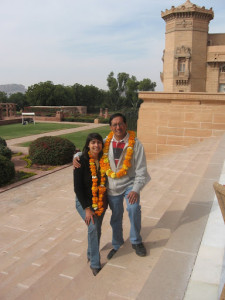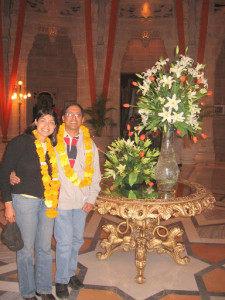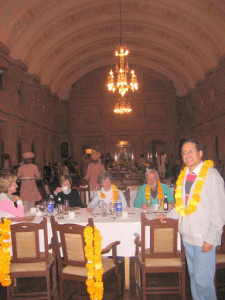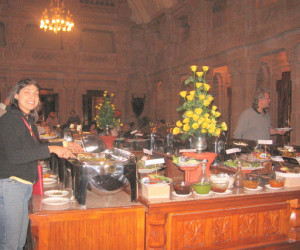If Jaipur is named The Pink City, Jodhpur–in my memories of twenty-two years ago–was the Blue City—so-named because the walls of this settlement are coated over with indigo paint to keep away pesky mosquitoes. The end result is that the city appears like one of the landscapes on the famous Blue Pottery made in this region of Rajasthan, especially when viewed from the heights of the Mehrangarh Fort that dominates the town and seems to watch closely over it with an insistent eye.
The Magic of Mehrangarh:
Mehrangarh towers above the visitor’s head (left), a collage of steeply rising yellow walls, ornamental balconies and buildings, latticed railings and carved doors that conceal sumptuously decorated royal rooms. One rises to the ramparts of the fort in a high speed elevator that belies the age of the building in which it operates. Once I alighted at the landing, the sheer ingenuity of the architectural accomplishments astonished me—below lay a maze of narrow streets shored up by sturdy stone walls while in the distance, the Blue City sparkled in the watery sunlight. From the red sandstone ramparts, the faint outline of the royal cenotaphs at Jaswant Thadda on the banks of a greenish lake lay closely visible.
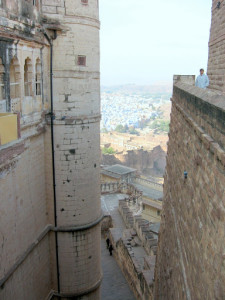
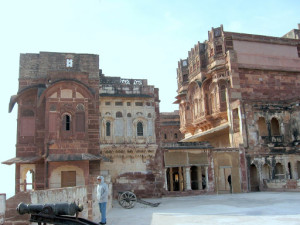
A ramble around the fort’s precincts took us to what seemed like secret enclaves concealed behind bamboo screens or ‘chics’.
Room after room revealed itself as a dazzling muddle of mirror-worked walls and stained glass windows. Of these rooms, two stand out and demand attention: The Takat Mahal with its exuberantly painted walls and wooden beamed ceiling which was reportedly the room in which the maharaja frolicked with his innumerable concubines and the Moti Mahal or Pearl Palace where the stained glass on the windows was imported from Europe. In this Hall of Public Audience that is liberally decorated with gold leaf and strategically placed mirrors, fat bolsters, upholstered in silk, provide the visitor with an idea of how the room might have been used by its erstwhile royal occupants. In the zenana where the ladies lived, hidden away from the envious eyes of the rest of the world, large iron rings revealed the presence of billowing silk tents once erected on festive occasions and also to provide shade in the summer months. In what seemed like a honeycomb of little rooms, guides pointed out the living quarters of the ladies of the harem, bringing a romantic twist to our fertile imaginations.
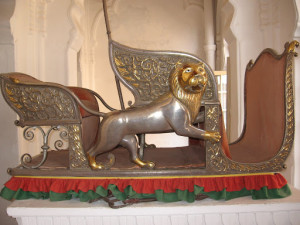
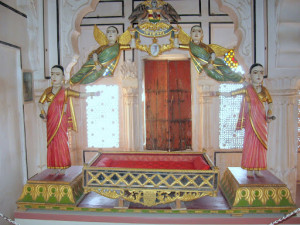
Mehrangarh Fort houses a superb museum with marvelous remnants of the accoutrements that made privileged lives special—howdahs in solid sterling silver (above left), carved wooden cradles that once rocked royal babies (above right), richly gilded palanquins that once sheltered coy concubines and courtesans, jeweled swords and gem-encrusted scabbards, and a lovely clutch of miniature paintings beautifully displayed. Alas, I had only a little while to gaze upon these treasures for the attractions of the next room made insistent demands.
Thanks to the labors of an NGO, the Mehrangarh Fort has a world-class museum shop that stocks everything from silk paintings and postcards to jewelry studded with precious gems and cheap cotton scarves and we contributed to its success by our many purchases.
Just a few kilometers away, we visited Jawant Thada, a spire-like temple of remembrance to those members of the royal family who were cremated in its environs. A series of beautifully carved marble cenotaphs are silent monuments to their once-privileged existence. As we walked, bare-footed, on the cool marble floors within, admiring the intricately-carved walls and the many altars with their curious niches, there was a great deal about Hindu cremation and mourning ritual that we could not comprehend. But we were glad to be in the quiet company of royal ancestry that had once held sway over these ancient princedoms.
An Art Deco Hotel in the Desert:
But Jodhpur has one more glittering attraction to offer the moneyed tourist—the splendor of the Umaid Bhavan Palace Hotel where Palace on Wheels passengers were treated to a splendid buffet luncheon. The dream-child of Maharaja Umaid Singh who in 1929 decided to create an Art Déco masterpiece to provide employment for his famine-stricken subjects, the gigantic dimensions of this sandstone edifice will quite take your breath away long before you have even set foot on its red-carpeted floors.
If the other genuine palaces of Rajasthan do not stir your senses, this one certainly will—its grand central dome projects upwards flanked by four minaret-like towers that combine modernist aesthetics with the Islamic lines of the Taj Mahal. Inside, in the grand reception area, carved balconies in several tiers lead the eyes upwards to the interior of the dome. Along the balconies are housed rooms that are now part of the luxury hotel.
If the buffet meal we were served is anything to go by (left), this hotel lives up to the dreams of its creator and continues to preserve memories of an opulent era.
In the beautiful sprawling gardens, we lost ourselves in the ambience of an older world. By the swimming pool, where the distant fort seemed to be mirrored in the still waters, I wanted to curl up and meditate quietly on the countless ways in which Rajasthan seduces the traveler.
(To continue to travel with us on our tour with the Palace on Wheels, please click on the Ranthambor link.)
Bon Voyage!
